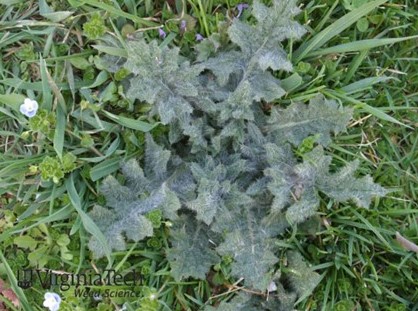 Weeds can pose serious threats to hayfield yield and quality. (Image: Virginia Tech)
Weeds can pose serious threats to hayfield yield and quality. (Image: Virginia Tech)
- Winter annual weeds will grow rapidly in early spring and diminish both quality and yield of the forage crop.
- Identify the prevalent weeds and determine whether they are annuals, biennials or perennials, because treatment recommendations vary.
- The key with weed management in pastures and hayfields is to keep weeds from maturing and producing seeds.
As spring temperatures steadily rise, our grasslands become green again and unfortunately, may also develop a new crop of weeds. If you missed the opportunity to control these weeds last Fall, late March through April is the next best time period. Weeds impacting cool season pastures and hay fields are generally easier to control while in the seedling stage or pre flower (winter annuals) and bolting (most biennials) growth stages.
While scouting for weeds, especially in pastures, be sure to consider the populations of desirable broadleaf plants (white and red clovers) which would likely be taken out by the weed herbicides most frequently applied. If removing weed infestations are highest priority, these clovers may need to be sacrificed and reseeded the following year or as per reseeding time period indicated in the herbicide label. Also be careful of new seedings made last fall to make sure they have grown sufficiently (established) to tolerate herbicide application.
Later in the growing season, newly emerged summer annual weeds, (lambsquarters, ragweed, etc.) may require an herbicide treatment between hay cuttings or grazing rotations.
The plant growth regulator herbicides 2,4-D, dicamba (Clarity) along with those containing triclopyr (Crossbow) are usually very effective this time of year. New products, like Duracor cover a broad spectrum of weeds as well. Note: Aminopyralid is not labeled for use in all states, so be sure to check the label). Typically, broadleaf herbicides will be most effective when air temperatures are at 50 degrees Fahrenheit or above for several days at the time of application.
For crop specialists, FS Crop Protection Handbook contains a section on pasture weed herbicides, with weed control ratings congruent with land grant university recommendations. Be sure to check the product label for specific weeds, application rates and associated restrictions. Several broadleaf weed herbicides can retard the growth of smooth bromegrass and fescues at certain time periods and application rates, so be sure to check the herbicide labels for guidance.